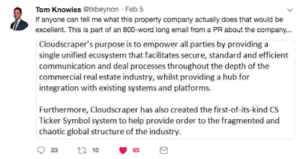So what makes you the expert??
Time to read: 2 minutes
How can you prove your clients are the zen masters they say they are? We go in search of those elusive proof points.
We know journalists get hundreds of pitches every day. Their mailboxes and twitter feeds are full of companies competing for airtime, all offering informed, relevant comment. But why should a journalist listen to what they have to say?
Your client may be a world expert in their field, whether that’s digital widgets, cloud computing or new legislation.
But if you can’t make them instantly credible in the eyes of the journalist, they’ll go straight to the deleted folder.
Once a client wanted to remove a statistic from our pitch because a) he thought it wasn’t that strong and b) he wasn’t sure it was accurate. We pointed out that, while we understood his concerns, we needed something concrete to show that they were well established, had delivered a lot of great work and hence were worth listening to. We thought the number was convincing, but if it couldn’t be used, it was vital to have an alternative.
One way of gaining credibility is to name high-profile customers. This isn’t easy, unless you can persuade your client to include ‘permission to be named in marketing materials’ in their standard contract (yes this can happen). However, there are creative alternatives. For example, when one customer mentioned that they worked with one-third of the London Boroughs, we didn’t need names – the statistic was enough. Similarly, the phrase ‘working with law enforcement agencies’, as was the case with one Comms Crowd client, speaks for itself.
Demonstrating credibility can be even more difficult in the finance sector, where every ‘expert’ has professional qualifications and offers similar services, and you will have to dig a little deeper. Links to topical issues can help, as can the ability to understand both sides of an issue. We’ve obtained a lot of coverage for one client on the topic of angel investment because not only does he advise clients on obtaining investment, two of those clients have appeared on Dragons’ Den and he also invests as a business angel himself. So he is extremely credible.
Another option is to work with experts whose credibility is a given, such as academics. Hitching your wagon to a star, to quote Ralph Waldo Emerson, can be an effective way of enhancing your own credibility, particularly if your opinions complement those of the expert.
If you’re still struggling for hard facts, the solution may be your client themselves. One of our favourite clients is someone who really ‘gets it’ where journalists are concerned. No matter how busy he is, he’ll quickly give us a short, snappy, often controversial comment to pitch which shows he knows his topic inside out, then makes himself available at short notice if the journalist wants to speak to him. As a result, he punches well above his weight in terms of influence and coverage.
It’s not easy finding proof points and can be even harder to persuade your client to let you make them public. However, it will be time well spent in establishing them as a credible source.
On K.I.S.S.ING – Keeping it simple, stupid!
Time to read: 2 minutes
We keep it brief.
We saw this tweet from Tom Knowles a few weeks ago, And it stayed with us. We see this type of thing all the time. Paragraphs beyond paragraphs of long clunky words with no clear explanation as to what it is they are trying to say. You can spend what seems like an age watching a company description going around the various the heads and powers that be of a company. We know this as we’ve worked in-house too. Everyone wants to add their own point of view, something that makes them feel that they played a part in the creation of the copy. But in doing so, adding a long word here and a bit of jargon there, we can completely lose all sense of what we’re trying to say.
When you work for a company you can get so immersed in it and the technicalities around how it works that to come up with a simple sentence to describe what it does exactly can be the hardest thing. We see this a lot in PR too. When we ask a company for 800-1000 word article on a chosen subject its easy. When we ask for a two-sentence reactive comment, it seems to take all day. And it’s the same for us too. For some reason writing less always takes more.
Let’s take the example above with Tom Knowles. Tom is the property reporter at The Times so we can assume that this is a property company (if the PR has got the pitch right!) but what they actually do is anyone’s guess.
Tom’s a busy man. He needs to sift through hundreds if not thousands of emails every day looking for the best news stories all while writing insightful copy for tomorrow’s paper under tight deadlines. He doesn’t have time to read 800 word emails. Tom needs to understand clearly from the outset why this company is great and unique and why it is that he should be speaking to them.
Think about how you read a news article or blog. If you read the first 100 words and you’re either a) not interested or b) you can’t see where it is going, then you are going to switch off and move on to something else. It’s the same with PR pitches. You’ve got to be succinct right from the start and make it very clear why your client is so interesting.
We’ve often questioned if our pitches to journalists can at times be too simplistic. We go back through them trying to add in fancy adjectives and make things sound perhaps more revolutionary than they actually are. What our clients are paying us to do is make sure that the journalist understands why they are so great and why we think it will make a good story. Translating this 800 word description in to two or three easily digestible sentences that get the journalist interested and want to find out more.
So next time you’re thinking about your ‘story’ find the three things that you think make it unique and interesting and express these points high up in your pitch. If you can capture the journalist’s attention in the first two sentences, then that’s half the battle won. If you’re not entirely sure what these key messages are, then it’s time to go back to the drawing board and start the process again.
You don’t need to give the journalist a life story about the company and the 30-year career of the chairman
Keep it brief. If the journalist is interested in the story that you are pitching then they will come back to you with questions. Keep it clear, to the point and highlight why it’s interesting in a couple of short sentences. Keep it simple.
How to get a bank to put its name to a story
Time to read: 2 minutes
Throughout her career, Sam Howard has always maintained that providing PR for fintech companies isn’t rocket science, however it is a bit tricky. Not only are you, the PR, the only person in the brain-chain without a PhD or three, which can leave you feeling perma-insecure; but also ‘tis hard to tell good stories if there are no good stories to tell.

Listening banks are great but talking ones are my favourite
Actually no news isn’t good news – but owing to the nature of the deals, it is not unusual for a small or a start-up fintech company to have just a few client signing announcements a year and those signings usually fall into three categories:
- The no comment: you may not mention the bank in anyway shape or form – great thank you sooo much for that one.
- The vanilla bean: you can prepare something but the details are to be so vanilla and that the quote so bland that it’s barely worth the effort.
- The never never: You get the go ahead on the Friday night, write it on a Saturday, it gets signed off by your team on the Sunday and it’s with the bank for approval first thing Monday morning. And there it will stay, stuck in the corporate food chain awaiting sign off forever more, never to be seen again.
Five tips for getting a bank to sign off a press release
Over the years, working for a fintech start-up, then a fintech multi-national and then a fintech PR agency, these are the tactics I have seen work. It’s a bit of a team effort:
- Incentivize your sales people to negotiate press as part of the contract. Cash bonuses for press releases and double again for a case study, seems to work well enough
- Incentivize your bank by giving them a discount in the contract if they agree to do press, get dates.
- During the sales process and the implementation, stay close to your champion in the bank and work directly with them on the story, using them as the spokesperson, and making sure your story shows your champion as the pioneer they truly are.
- Have the release written and ready to go so that it can be slipped under the nose of your happy, happy client the day everything goes live ahead of schedule and under budget.
- Make the release hardworking and insightful tell the story of the partnership between your company and the bank. Do not dwell on what was wrong in the first place, be realistic no bank is going to sign off a story that goes, ‘well it was just chaos here till you guys showed up’. And keep the quotes real and relevant not an unadulterated and shameless plug for your company. This will make it easier to get sign off, and more credible with the journalists, on whom you ultimate depend to publish it.
What if you hit an absolute wall and can’t get the bank to talk no way no how?
Rather than issuing a no name press release, which somewhat reeks of desperation, consider going down the analyst relations route where your client can freely talk about the project and its successes to the industry analysts under the comfort of NDA.
Top ten tips for writing snappy copy
Time to read: 2 minutes
Because B2B commercial copy is for intelligent business consumption, it’s tempting to make it sound grand, but this inevitably makes consumption so much more painful.

Here’s my top tips for edible copy:
- Who are you writing for? Write for one person. Assess their motivation for reading your copy. Will it enlighten, inform, entertain, motivate them to act? Think what’s in it for them. Assess the time they have to read it, their knowledge level.
- Get the knowledge: Sounds obvious, but you need to know/understand at least as much as your reader. If you don’t have the knowledge go and get it. Research it, ask questions, find an expert, get them to draft it if necessary.
- Get it all out: If you find yourself staring at a blank screen then just write anything and everything down to do with what you are trying to say, from this you can create structure, and extract key facts.
- Ask questions which can provide the structure: Ask yourself some basic questions like, Who, Why, When, Where, What and answer them in bullet format. Leave the questions as subheads for now. Arrange the questions into a structure that will form the basis of your logical/persuasive argument.
- Does it serve your purpose as well as theirs? Your copy must add value to the reader but does it also support your company messages, make sure your copy always underlines a key value proposition. If it doesn’t why are you writing it?
- So what? Then read it through, anything missing? Ask yourself, ‘Why do I care?’, ‘So what?’ and, ‘What’s so exciting about that?’ If you’re bored by your own copy, imagine how everyone else feels. (At this stage this might be the longest your copy gets, from here on in we are cutting it back).
- Show not tell: De fluff: Use objective observation and facts to show. Not subjective adjectives and opinion to tell. You are not penning a love letter, but presenting the facts in a compelling fashion. Imagine the building is on fire and you cannot leave the office until you have shouted the story from the window. This exercise will ensure you only use the words you need, to say what has to be said and no more. When it comes to strong copy, a couple of carefully crafted sentences are more effective than a whole paragraph of jumbled thoughts.
- Every time you review it, cut it: Aim to reduce word count every time you review the copy (3-5 times) with decent breaks in between sessions to allow the creative brain to mull over the project, find the right phrase, the most perfect word.
- Don’t force it: Could you sneak your copy into conversation, would it sound natural, or would people think you had gone crazy/swallowed a dictionary/been indoctrinated by brand Y. Be kind to your reader, make your copy easy to read!
- Read final draft out loud: Now print off the copy and read it out loud. This really helps spot the ‘silly’ mistakes that your eyes haven’t seen but your tongue will trip over. It will also help you with punctuation.
You can download these tips in a handy pdf if you like to keep on your desk and front of mind.

